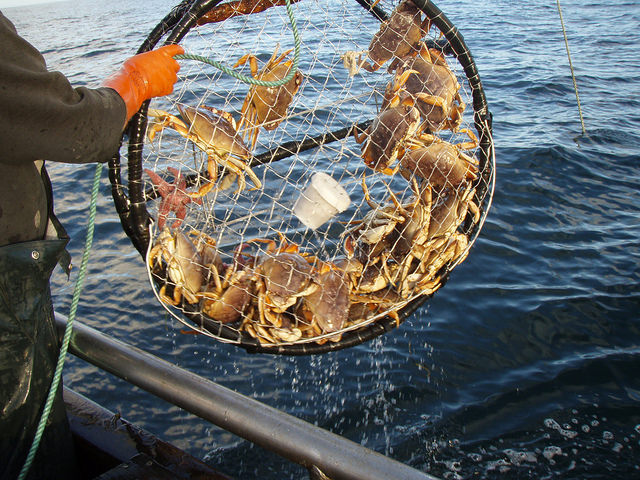
On Dec. 29, more of the California coastline will open to the commercial Dungeness crab fishery. Some previously closed areas will open at the recommendation of state health agencies, the California Department of Fish and Wildlife (CDFW) announced today.
The area between Point Arena and Ten Mile River in Mendocino County will open on Dec. 29.
However, due to persisting conditions of elevated domoic acid levels, the fishery will remain closed between Ten Mile River and Shelter Cove. The closed portions of the coast may open once testing by state agencies shows that domoic acid in crabs from the area no longer poses a significant risk to public health.
- On Dec. 29 at 12:01 a.m., the commercial Dungeness crab season will open from 38° 57.5′ N. Lat. (near Point Arena) to 39° 33.3′ N. Lat. (near Ten Mile River).The opener in this area will be preceded by a 64-hour pre-soak period commencing at 8 a.m. on Dec. 26.
The area between Ten Mile River and Shelter Cove will remain closed until the CDFW Director receives a recommendation from the state health agencies that levels of domoic acid – a naturally occurring toxin – do not pose a public health risk. Last fall and winter, domoic acid along the West Coast interrupted Dungeness and rock crab fisheries from Santa Barbara to the Oregon state line.
At the recommendation of the state Office of Environmental Health Hazard Assessment (OEHHA), CDFW Director Charlton H. Bonham submitted to the Office of Administrative Law an emergency rulemaking to keep the commercial Dungeness crab fishery closed north of Point Reyes and to close the commercial rock crab fishery north of Pigeon Point. State and federal laws prohibit the commercial distribution of seafood products that contain domoic acid levels above the federal action level of 30 parts per million in the viscera. Because of this, on Nov. 8, OEHHA, in consultation with the California Department of Public Health (CDPH), recommended to CDFW to close or delay the start of the commercial Dungeness crab season north of Point Reyes and close the commercial rock crab fishery north of Pigeon Point. Since then, much of the California coast opened to commercial Dungeness crab fishing as test results have come back below the action level. The recreational season for Dungeness crab opened on Nov. 5 and remains open with a warning from CDPH to recreational anglers to avoid consuming the viscera of Dungeness crab caught between Ten Mile River and Shelter Cove.
Closure of the above-referenced commercial fisheries shall remain in effect until the Director of OEHHA, in consultation with the Director of CDPH, determines that domoic acid levels no longer pose a significant risk to public health and recommends the fisheries be open, and the Director of CDFW provides notification to the commercial fisheries. Recreational fisheries will remain open under a warning to anglers not to eat the viscera of crab caught in the affected areas.
CDFW will continue to coordinate with CDPH and OEHHA to test domoic acid levels in crab along the coast to determine when the fisheries can safely be opened. CDPH, in conjunction with CDFW, has been actively testing crabs since early September and results from the most recent tests showed that select crabs from the closed areas had elevated levels of domoic acid in their viscera. Domoic acid is a potent neurotoxin that can accumulate in shellfish, other invertebrates and sometimes fish. It causes illness and sometimes death in a variety of birds and marine mammals that consume affected organisms. At low levels, domoic acid exposure can cause nausea, diarrhea and dizziness in humans. At higher levels, it can cause persistent short-term memory loss, seizures and can in some cases be fatal.
For more information:
Memo from Office of Environmental Health Hazard Assessment (12/23/2016)


 Advertising
Advertising